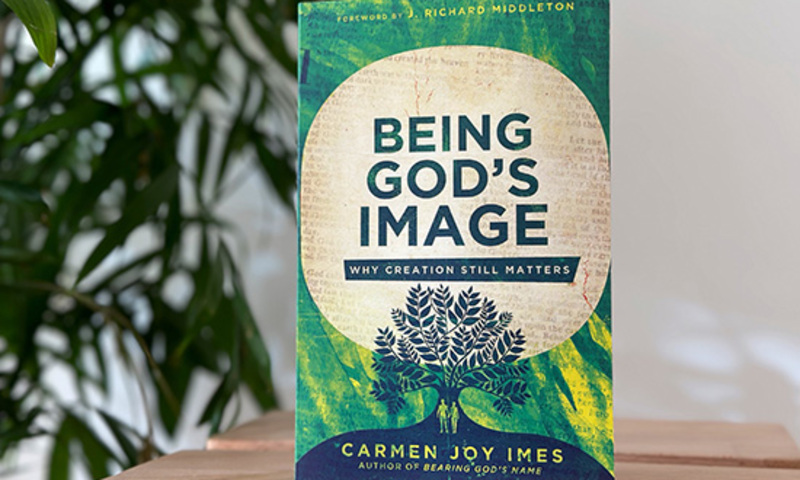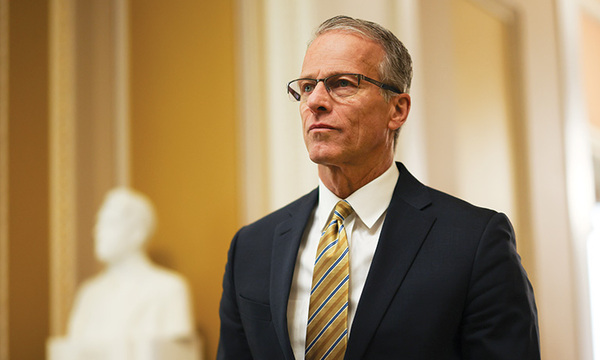On the first page of the Bible, we read that humanity is created “in the image of God” — a phrase that has inspired a great deal of theorizing and theologizing throughout the centuries. Most Christians have understood the term to have something to do with humanity’s special position within God’s creation, but opinions get more divided on the specifics: Does the image of God primarily have to do with our spiritual and intellectual awareness? Is it more connected to our capacity for relationship with God and others? Or is it tied to our God-given task in the world? Perhaps all of the above? Maybe none of the above?
In her new book, Being God’s Image: Why Creation Still Matters, Biola University Old Testament professor Carmen Imes seeks to bring clarity to the question of what it means for humans to be the image of God. Starting in Genesis and working her way through Scripture, she explores God’s plan and purpose for humanity — touching on topics such as disability, gender, vocation, community and more along the way.
Biola Magazine recently sat down with Imes to explore some of the themes in the book. The following interview has been edited for length.
Most Christians understand that the term “image of God” in Genesis 1 has something to do with human dignity and our special place in God’s creation, but they don’t necessarily know how to define it. How would you sum up what the “image of God” means?
There’s been such a long history of theologians speculating about what it means in ways that are not actually exegetically tied to the text and not informed by the cultural and historical background of the Bible. But we now have resources available to us that they didn’t have 200 years ago or during the Reformation as people were pontificating about the image of God, and thinking about how we are different than animals. We now know that the Hebrew word tselem (“image”) is actually something concrete. It refers to a statue or an idol in a temple. With that insight in mind, I think it’s important to recognize that to be God’s image is to be physical — to be embodied and to thereby represent the presence of God in the world.
God made creation and he reigns over it as king, but he’s not physically present everywhere at once, so he appoints humans to represent him. The only prerequisite for being God’s image is having a human body. That’s foundational to my understanding of the image. Yes, we have capacities as humans that are different than animals, but the biblical text doesn’t tie our status as the imago dei to those capacities, so I don’t want to tie those together either.
So it’s not defined by our intellect, or ability to reason, or our emotions.
Right, or by our moral compass or by our relational capabilities. And the reason why I think it matters that we disconnect those two is because as soon as you define the image of God as rationality or intellect, then you have a sliding scale of humans who are more or less intellectual or more or less rational. And that is ripe for all kinds of abuses — not only treating some people as less than human, but also, who gets to decide what qualifies as rational? To talk about the image of God as human embodiment frees us from some of those pitfalls.
You refer in the book to “kinship and kingship” to help us think about the image of God. Can you unpack that a little bit?
What becomes clear in Genesis 5 is that the relationship of humans to our Creator is somehow analogous to the relationship of child to parent. Kinship seems to be implied by our being God’s image because Seth is Adam’s image in Genesis 5. So that is more of a core expression of what it means to be God’s image, whereas kingship is more of an implication of it. Our status or identity is that we’re God’s kin and we express that through kingship. But the reason I’m making a distinction there is because, again, if someone has less of an ability to exercise rulership for whatever reason — medical or intellectual disability or just some kind of limitation — then that doesn’t make them less human or less the image of God.
Most of us are used to hearing that we are made in God’s image or that we bear God’s image. But you’re advocating for a different understanding — being God’s image. What’s the distinction and why does it matter?
This is a hard habit to break, because even I found places in the book where I talked about bearing God’s image or imaging God, and I didn’t mean to. The reason I’m being a stickler about that language is because if we talk about bearing God’s image, then it’s something external to ourselves that we’re carrying, which we could set down or lose or be taken from us. But if we talk about being God’s image, then it’s intrinsic to our humanity and it can’t be separated from us. If we talk about imaging God — if we make it a verb — then it’s something we do rather than who we are. And I really believe the Bible teaches that the imago dei is who we are. It has implications for what we do, but it can’t be limited to what we do.
You suggest in the book that Eden wasn’t just a paradise to be enjoyed — it was a project to expand. Humans were called to enlarge the borders of Eden, taking the order of the garden to the disorder around. How does that help us understand our work and vocation?
In Genesis 1 when God makes all things, he calls it good, but he doesn’t call it perfect or finished. God did finish creating, but some of what’s there is potential to be developed, and the role of humans is to cultivate creation. We’re told in Genesis 2 that there was no one there to work the garden, and so God made Adam. So there seems to be a need for human participation in God’s creative work, and that’s where we’re representing him. We have a job to do in cultivating creation and in maintaining order, or even bringing order to places of disorder. Outside the garden, the world is disordered. The idea is to expand the boundaries of sacred space and ordered space, so that not only humans can flourish, but animals and plants can flourish as well.
And that’s not just a spiritual labor.
No, it’s physical. This is why I give my students extra credit if they go out in groups and pick up trash on campus, because that’s actually their human vocation: to bring order to the garden. This is the garden and we need to continue to maintain it. It’s our job. There’s no other species that’s going to do it for us.
If the image of God is something that we all equally share, regardless of our cognitive or physical abilities, how should that under.standing motivate the way that the church cares for people with different abilities?
Not only should the doctrine of the imago dei motivate us to care for people with disabilities, but also to recognize that they have contributions to make to the community. They’re not just on the receiving end of our sympathy. It’s not just reaching out and trying to make things accessible for others, but also recognizing this is a human being that God has put on this planet, and every human being, by virtue of being human, has dignity.
We have a deep-seated assumption about what makes someone valuable. In the West, it revolves around what we can produce, and production is defined in a pretty narrow sense. Those around me with disabilities remind me that there are values other than productivity. That is something that we need to rediscover and cherish in the church. We can start that process by asking: Where are we failing to remove barriers for full participation in worship? Who’s not here, and why are they not here? And how have we made it difficult for them to be here?
You noted earlier that being embodied is core to what it means to be human. What are we losing as we increasingly have so many interactions online?
We lose out as soon as we forget that on the other side of the screen is an embodied human. When we begin to talk to people online in ways that we wouldn’t talk to people face to face, that’s problematic. I try never to say anything about anyone in print or online that I wouldn’t want them to see. And I don’t follow that perfectly, but that’s been a good guiding light for me.
I think Covid-19 pushed us to ask important questions: What do we mean by church, and what are we doing when we gather for church? If it can be done by watching a You.Tube sermon or turning on some Spotify music at home, then why go back to church now that the restrictions have lifted? As James K.A. Smith would put it, we’re not just brains on a stick. We have bodies. We can’t fully convey who we are through a screen. Technology is a wonderful tool to connect with people across distances, but it can’t replace embodied fellowship.
You’ve got a section in the middle of the book on what we can learn from the Bible’s wisdom literature about what it means to be human. Ecclesiastes is one of those books that can be a puzzle for folks, because it just feels bleak or meaningless. But you have an interesting take on it that diverges from a lot of people’s popular conceptions. Can you sum up what we can learn from Ecclesiastes?
Yes, so I am a fan of the NIV, but this is one place where I think the NIV has not done us a favor by the way they’ve translated one Hebrew word that occurs dozens of times in the book of Ecclesiastes. The word is hevel, which they’ve translated as “meaningless.” The book opens with “Meaningless, meaningless. Everything is utterly meaningless.” And then it’s natural to ask, what is this doing in the Bible, because it doesn’t seem like that is consistent with the rest of the teaching of Scripture. But the Hebrew word is actually a metaphor. It means vapor or smoke. It’s something intangible and transient. The point is lost when we try to get around the metaphor. The voice in Ecclesiastes is trying to say “Vapor, vapor. Everything is utterly vaporous.” That is, it’s transient; we can’t fully grasp it or keep it or hold onto it. The message of the book is not that life has no meaning, but rather that the meaning of life is difficult to grasp. And the key to a happy life is to enjoy the journey — and not always keep reaching out, trying to grasp for what we don’t have yet. And so I find the book a really powerful antidote to our production-driven, climbing-the-corporate-ladder kind of world, where it seems like even my students are on a journey of always reaching out for something they don’t have yet.
I used this in class this semester. I said to them: Some of you did not enjoy high school because you were so stressed trying to get a high enough GPA to end up at Biola, and you thought this was going be the thing. But as soon as you got here, you realized that you had to put everything into success here, so that you could land the right internships, so that you could land the right career. And so you’re not enjoying Biola because you’re too busy worrying about what career you’re going get on the other side. You’re going to get to that career and you’re not going to enjoy that either, because you’re going to always be worried about the next promotion that’s just out of reach, or finding that special someone to spend your life with, or having a child, or buying that house, or getting that dream vacation. There’s always going to be something that’s out of reach. And Ecclesiastes is an amazing antidote to that hopeless way of living because he says, I’ve tried it all. None of it ultimately satisfies. The key is just to enjoy the gifts that God has given you today and to relish those. And that’s where the phrase “eat, drink and be merry” comes from — the recognition that we don’t have tomorrow. All we have is today. And so we need to learn to enjoy today.
You teach a free class on Exodus through BibleProject. You have a popular YouTube series called “Torah Tuesday.” You’ve written for Christianity Today. And you’re a frequent guest on a number of different podcasts. Clearly, you love the Old Testament — and helping as many people as possible understand and appreciate it, too. What drives that?
I remember loving the Old Testament even as a child. I can’t really remember a time when I didn’t love it. When I was in Bible college, I felt like I gained the tools for the first time to really know how to read it well and be confident that I wasn’t distorting it. I recognize that that’s a real problem in the church — people know they’re supposed to love the Old Testament, knowing that the whole Bible is the word of God. They know they’re supposed to read it and put it into practice. But there seems to be such a big gap between where we are and what the text says, and so they’re not sure how to bridge that gap. That’s really what got me into this work, is wanting to help people discover what’s there and see that this is not something opposed to the New Testament. The God of the Old Testament and the God of the New Testament are the same God, and we can see his grace and mercy on display in the Old Testament. Even the wrath we see in the Old Testament is also present in the New Testament. Just connecting those dots for people so that they can see there’s coherence in the story of Scripture. And I am just so blessed by how many people are out there — institutions, podcasts, publications that are also trying to do the same thing. So I’m happy to lend my voice to these projects and do what I can to help people rediscover Scripture and be empowered to engage it, instead of feeling overwhelmed by it or put off by it.
– Interview by Jason Newell
 Biola University
Biola University




